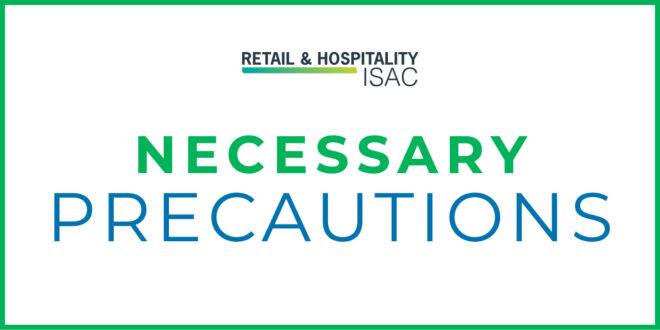By Luke Vander Linden, Vice President, Membership and Marketing, Retail & Hospitality ISAC
 In the retail industry, the escalation of online transactions and digital customer interactions has magnified the importance of cybersecurity. Retail operations, which often hold vast amounts of sensitive data from customer payment information to supplier details, are increasingly targeted by cyberthreats. The interconnectedness of online inventory systems with in-store operations also poses unique vulnerabilities. As such, robust cybersecurity measures are no longer optional but are a cornerstone for safeguarding business continuity, maintaining customer trust and ensuring compliance with data protection regulations. For independent home improvement retailers, where transactions are frequent and stock turnover is high, a breach can be especially damaging, emphasizing the need for a preemptive and comprehensive approach to cybersecurity.
In the retail industry, the escalation of online transactions and digital customer interactions has magnified the importance of cybersecurity. Retail operations, which often hold vast amounts of sensitive data from customer payment information to supplier details, are increasingly targeted by cyberthreats. The interconnectedness of online inventory systems with in-store operations also poses unique vulnerabilities. As such, robust cybersecurity measures are no longer optional but are a cornerstone for safeguarding business continuity, maintaining customer trust and ensuring compliance with data protection regulations. For independent home improvement retailers, where transactions are frequent and stock turnover is high, a breach can be especially damaging, emphasizing the need for a preemptive and comprehensive approach to cybersecurity.
Cybersecurity is increasingly becoming an integral part of traditional loss prevention methods in the retail industry. Where loss prevention once focused primarily on physical theft and fraud, it now encompasses the digital realm where data breaches and cyberattacks can lead to significant financial loss and damage to reputation. Traditional surveillance and security measures are being augmented with cybersecurity protocols to protect against online threats.
The convergence of these two fields involves implementing secure payment systems, protecting against data theft and ensuring that both online and offline defenses are aligned to provide a comprehensive shield against all forms of retail loss. This blending of cybersecurity with physical security strategies is essential for a holistic approach to loss prevention.
Retail’s Cyberthreat Landscape
Retailers face myriad cyberthreats that can disrupt their operations and compromise customer trust. Phishing attacks, where malicious emails masquerade as legitimate correspondence, aim to steal sensitive information such as login credentials and credit card numbers. Ransomware can lock retailers out of their critical systems, demanding payment to restore access. Increasingly, ransomware operators are skipping the locking step and proceeding straight to extortion exchange for not leaking stolen data.
Point-of-sale (POS) system breaches are particularly insidious, allowing cybercriminals to siphon off customer payment information with each transaction. Additionally, distributed denial of service (DDoS) attacks can overload and shut down retail websites, not only halting online sales but also damaging the retailer’s reputation.
Home improvement retailers face specific cybersecurity challenges due to the nature of their inventory and customer base. They often manage large databases of detailed inventory, which can include hazardous materials requiring strict regulatory compliance, making data integrity crucial.
Retailers should also secure their customer loyalty program database, which contains personal customer data vulnerable to theft. The challenge is further compounded by the need to protect online platforms that provide color-matching and custom-order services, which are prime targets for cyberattacks aiming to disrupt operations or steal intellectual property.
Protecting Your House
Imagine cybersecurity as an advanced security system, where you have locks on doors, alarms and a plan in case of an emergency. For retailers, a similar multilayered approach is key to keeping your digital “house” safe.
First, think of regular updates to security systems and the software for POS systems as routine checks to ensure locks are sturdy and alarms are working. These updates act like reinforcements against new methods that digital thieves use to break in.
Next, we have end-to-end encryption for all online transactions. This is like sending a message in a securely locked box that only the sender and receiver can open, ensuring that no one else can read it while it’s in transit. It keeps customer data like names, addresses and credit card information safe from prying eyes from the moment they start the purchase until it’s complete.
Teaching staff about cybersecurity is like having a neighborhood watch. They learn to spot suspicious activities, like phishing—fraudulent attempts to get sensitive information through seemingly legitimate emails—and can avoid giving out the keys by accident.
A robust firewall is the fence around your property, keeping out unwanted visitors. Secure Wi-Fi networks are like having a private road to your house; it’s monitored and less likely to be traveled by criminals looking for an opportunity. Be sure there are separate Wi-Fi networks available for customers to connect to as an additional layer of protection.
Finally, conducting regular security audits is like having a safety inspection to find any weak spots in your home’s security before they can be exploited. And if an intruder does get in, having an incident response plan means knowing exactly who to call and what to do, so you can stop the theft and get back to normal as quickly as possible, thus maintaining the trust of your customers who rely on you to keep their shopping experience safe.
Connection Points
Integrating physical and digital security measures in retail stores is a strategic approach that strengthens the overall defense against theft and data breaches. In a typical retail setting, physical security measures might include surveillance cameras, security personnel, alarm systems and secured access points. Digital security, on the other hand, involves protecting the IT infrastructure with firewalls, anti-malware software, secure Wi-Fi networks and encryption protocols.
In practice, this integration can manifest in various ways. For instance, surveillance cameras can be connected to a network that is monitored remotely through a secure connection. This allows for real-time surveillance and, if the cameras are equipped with advanced features like motion detection, they can trigger alerts to security personnel and simultaneously lock down POS systems in the event of an unauthorized breach.
Furthermore, access control systems at the entrances and exits of a store can work in tandem with employee identification systems to ensure that only authorized personnel have access to sensitive areas, both physically and digitally. For example, a staff member’s access card might grant them entry to a storage room while also allowing access to the store’s inventory management system, tying together their physical movements with their digital access rights.
Another example is the integration of POS systems with inventory databases. The POS system can be programmed to automatically update inventory levels as sales are made, which requires a secure network to protect against cyberthreats that could lead to inventory discrepancies, affecting both sales data and physical stock levels.
These measures create a cohesive security environment where both the tangible goods and the data that represents them are guarded. By doing so, retailers not only deter and detect theft but can also provide a swift response to any security incidents, thereby minimizing potential losses and maintaining operational integrity.
Cybersecurity is crucial for the independent home improvement industry, serving as a critical part of loss prevention tactics and strategies. Secure transactions, data protection and staff training form the frontline defense against cyberthreats. Combined with physical security and a solid incident response plan, these measures build a comprehensive safeguard for retailers. Proactive cybersecurity is not optional—it’s a vital aspect of maintaining customer trust and ensuring business resilience and longevity.
Fact or Fiction: Cybersecurity
“I have a small business, so I’m not at risk for cyberattacks.”
According to the National Cybersecurity Alliance, cybercriminals often target small businesses because they are easier to infiltrate. No matter the size of their operation, business owners have a responsibility to protect the information they’re collecting.
“Protecting the company from cybersecurity threats is the responsibility of my whole staff.”
More than 90% of cybersecurity incidents start with an email. Send all email users through a cybersecurity training program, and only give people access to the data they need, even executives.
“My customers don’t expect me to make the same investments in cybersecurity as big-box stores.”
Consumers expect their data to be protected when they use a credit card or sign up for a rewards program. For small businesses that rely on customer loyalty and trust, it can be difficult to recover from cybersecurity incidents.
“There are cybersecurity solutions within my budget.”
While there are low-cost options, implementing cybersecurity protections should be part of overall loss prevention. Whether you’re protecting against bad weather or the dark web, taking it seriously does require time and money.
About the Retail and Hospitality ISAC
The Retail & Hospitality Information Sharing and Analysis Center (RH-ISAC) is the trusted community for sharing sector-specific cybersecurity information and intelligence. The RH-ISAC connects information security teams at the strategic, operational and tactical levels to work together on issues and challenges, to share practices and insights and to benchmark among each other—all with the goal of building better security for consumer-facing industries through collaboration.
Cybersecurity Specialists
Learning from experts is crucial to making the right choices in cybersecurity. Access free cybersecurity resources available to NHPA members at rhisac.org/NHPA.
 Hardware Retailing The Industry's Source for Insights and Information
Hardware Retailing The Industry's Source for Insights and Information






